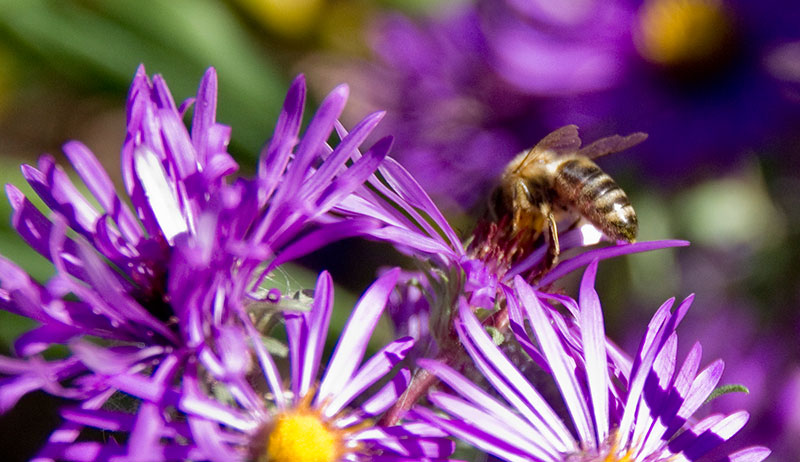
PHOTO: Kristina Mercedes Urquhart
What we all know best about the honeybee is how it behaves out in the world while foraging. That was our relationship with bees before we became beekeepers: watching the bees gently float from flower to flower, the sound of their buzz alerting us to their demure yet powerful presence. There are many things we know about honeybee foraging trips: They visit flowers in search of nectar, turn that nectar into honey, and pollinate so many fruits, vegetables, herbs and flowers by doing so. What we don’t know until we become beekeepers is what else honeybees do in the field, how they get there and so much more.
The Plant’s Role
- Honeybees forage for nectar, but they also forage for water and tree sap, aka resin, to make propolis (bee glue).
- Honeybees only collect nectar that is higher in sugar content—no less than 5 percent.
- Honeybees pollinate while on their foraging trips; without their services, 1/3 of the foods we eat would not be available to us.
- While foraging, a single honeybee will visit only one variety of flowering plant per trip. Beekeepers call this pattern species fidelity. This ensures proper pollination and a reliable amount of the same kind of nectar. Whether the honeybee knows this or not is a mystery.
- Area fidelity is the term used to describe a single honeybee’s commitment to a particular foraging area—the bee returns time and again as long as the nectar remains abundant.
- Plants produce nectar in special glands called nectaries. These glands are usually located inside of flowers, but they may also be on the petals, between bracts or under leaves.
- Nectar contains a watery variety of sugars but also contains tiny amounts of proteins, trace minerals, amino acids and enzymes. It’s this very special mix that both attracts the honeybee to the flower and makes it possible to create the amazing product that is honey.
Leaving the Hive
- Each morning, a small number of scout bees leaves the hive in search of flowering plants and nectar. They return to the hive with information on the best and most abundant sites, sharing this information with other bees standing by.
- Returning foragers and scouts use a series of dances called waggle dances to share precise location information about food sources to prospective foragers.
- Field bees forage in a radius of between 3 and 6 miles around the hive. They prefer to stay within 3 miles of the hive, but will go farther if a dearth calls for it.
- Foraging bees from a single hive prefer diversity of plant species over close proximity, so they’d rather go a bit farther to forage from several varieties rather than easy pickings of one plant close to home. The nutritional value of pollen varies dramatically from plant to plant, so foraging in this way provides better nutrition to the colony as a whole.
- If foragers encounter their sisters while out foraging, they will choose different plant species to gather from, ensuring both diversity of resources and fidelity to their hivemates.
- Bees see color and shapes of flowers, helping to guide their foraging trips.
- A honeybees uses its long tongue, called a probiscus, to reach the fluid out of a flower’s nectary. The nectar is then stored in the bee’s honey stomach, a special stomach used solely for the transportation of nectar, for the return flight home.
Returning Home
- Upon returning to the hive, foragers regurgitate the stored nectar and pass it along to a house bee that stores it in the appropriate cells, where it will be fanned into honey. The foraging bee then turns right around and goes back out again. It does this over and over until daylight or the nectar is gone.
- To make 1 pound of honey, several thousand bees fly about collective 45,000 miles, or the equivalent of two trips around the world.
- The honeybee’s sense of time is impeccable; they know exactly when a flower has available pollen and nectar throughout the day and they will synchronize accordingly.
- When weather is ideal, flowering plants are in bloom and full of nectar, and a hive is sending out thousands of foraging bees, a single colony may be able to bring in 5 to 6 gallons of nectar in a single day!
- During rainy weather, or when an individual bee’s variety is not producing (say, a morning strong variety wraps up production by noon), the foraging honeybee is finally able to rest. It may sit idle in a resting position with its sisters, who are also on a break. It may sleep, in its powered down mode or meander about the hive.
- Foraging honeybees often work until they die. Deceased foragers will appear very worn, often with tattered wings, evidence of their tireless hard work.



